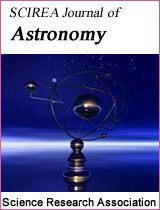Ultrasonic technology of detection of gravitational waves of neutron stars - pulsars
DOI: 10.54647/astronomy160044 94 Downloads 96657 Views
Author(s)
Abstract
The work relates to the creation of new methods and instruments for observational astronomy, in particular to gravitational astrophysics. The ultrasonic gravitational method for obtaining information about such exotic objects as neutron pulsar stars has been developed and successfully tested. Gravitational waves are detected by isolated and processed ultrasonic signals propagating in acoustically transparent media. With the help of the developed equipment, it is possible to observe in the gravitational range any star out of many millions of actually detected neutron pulsar stars. The operation of the equipment allows measurements to confirm the stationarity and high stability of the gravitational frequency of a selected neutron star pulsar. The precessions of most neutron pulsars are detected in real time while confirming the high stability of their precession frequencies. Gravitational-wave glitches of some neutron pulsars have been detected, namely, unsteady variations of the frequency and amplitude of their gravitational oscillations, with amplitude increases of individual pulsars up to hundreds or thousands of times when their frequency changes by a small fraction of a percent. The equipment makes it possible to selectively isolate and listen to the selected neutron star-pulsar in the audio frequency range. The importance of the obtained results lies in the possibility of abandoning the expensive projects of creating gravitational observatories based on laser-interferometric methods of observation.
Keywords
the equipment, neutron stars pulsars, detecting gravitational waves
Cite this paper
Chernobay Ivan Alesandrovich,
Ultrasonic technology of detection of gravitational waves of neutron stars - pulsars
, SCIREA Journal of Astronomy.
Volume 5, Issue 1, February 2023 | PP. 12-28.
10.54647/astronomy160044
References
| [ 1 ] | Chernobay I.A. Investigation of the gravity effect on propagating acoustic waves and the development on this basis of a new type devices/ I.A. Chernobay, V.I. Sadchikov, A.A. Sokolsky//Materials of the International Seminar "Conversion of Scientific Research in Belarus in the Framework of ISTC Activities". - Minsk, 1999 - Part 1 147-150 p. |
| [ 2 ] | Chernobay I.A. Hardware for registration of external influences on extending ultrasonic waves // Polish Journal of Science, 37(2021). 39-46. |
| [ 3 ] | Skuchik E. Fundamentals of acoustics. M .: Science, 1975.–Vol.1.–520 p.–Vol.2.–542 p. |
| [ 4 ] | Chernobay I.A. A new advanced method for detecting gravitational waves // German International Journal of Modern Science. 2021 – VOL. 1, No 7 – 19-31 p. |
| [ 5 ] | Chernobay I.A. Gravitational detection of neutron pulsar stars glitches // Materials of the 6-th International Scientific and Practical Conference "Applied Problems of Optics, Informatics, Radiophysics and Condensed Matter Physics", - Minsk, May 20-21, 2021 — P.254-257. |
| [ 6 ] | Chernobay I.A. Development of the capabilities of the ultrasonic method detecting gravity waves // German International Journal of Modern Science. 2021 – VOL. 1, No 23 – 23-36 p. |
| [ 7 ] | Sokolsky A. A., Sadchikov V. I. сoll. Gravitation and electromagnetism, Minsk, BSU, -1988 . - 177 p. |
| [ 8 ] | Lamb G. Hydrodynamics. M., 1947 -300 p. |
| [ 9 ] | Brekhovskikh L.M. Waves in layered media. - M: Nauka, 1957 . - 504 pp. |
| [ 10 ] | Abbott B.P., Braginski V.B. et al. LIGO: the Laser Interferometer. Gravitational – Wave Observatory // Rep Prog. Phys. – 2009 – Vol.72, No 7 C.07690 1 (25pp). |
| [ 11 ] | Abbott B.P. et al. Observation of gravitational waves from a binary black hole merger //Physical review letters. - 2016/2/11. – Vol. 116, No 6 – 061102 |
| [ 12 ] | Lee Billings, «Karga, l´eveil du geant sous la montagne», Pour la science, No 506, decembre, 2019 – 50-55 pp. |
| [ 13 ] | Misner C.W., Thorne K.S., Wheeler J.A., Gravitation, Freeman, San Francisco, 1973 |
| [ 14 ] | Abbott B.P., Braginski V.B. et al. LIGO: the Laser Interferometer. Gravitational – Wave Observatory // Rep Prog. Phys. – 2009. – Vol.72, No 7. C.07690 1 (25pp). |
| [ 15 ] | Abbott B.P. et al. Observation of gravitational waves from a binary black hole merger // Physical review letters. - 2016/2/11. – Vol. 116, No 6. - 061102 |
| [ 16 ] | Klimashin, I.A. Relativistic astronomy / I.A. Klimashin. - M: Nauka, 1989 . - 286 p. |

